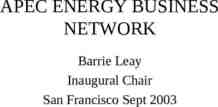Public Key Infrastructure Based on slides accompanying the book
49 Slides3.30 MB

Public Key Infrastructure Based on slides accompanying the book Computer Security: A hands-on approach by Wenliang Du (2017)

Public Key Cryptography - The public key and the private key in the same key pair are inverse.

Man-in-the-Middle (MITM) Attack against sharing of public keys Q: Whose DNS might be polluted?

What Is the Fundamental Problem? Fundamental Problem: Bob has no way to tell whether the public key he has received belongs to Alice or not. Q: Which type of security service is needed here? Solution: – Find a trusted party to verify the identity (of whom?) – Bind an identity to a public key in a certificate – The certificate cannot be forged or tampered with (using digital signature)

Digital Signature If the signature is not tampered with, M’ will be the same as M Only Alice can sign (she has the private key) Everybody can verify (public key is known publically)

Defeating MITM Attacks using Digital Signature Alice needs to go to a trusted party to get a certificate. After verifying Alice’s identity, the trusted party issues a certificate with Alice’s name and her public key. Alice sends the entire certificate to Bob. Bob verifies the certificate using the trusted party’s public key. Bob now knows the true owner of a public key. Q: What is the foundation of such a scheme?

Public Key Infrastructure Certificate Authority (CA): a trusted party, responsible for verifying the identity of a user/entity, and then bind the verified identity to a public key. Digital Certificates: A document certifying that the public key included inside does belong to the identity described in the document. – X.509 standard

Digital Certificate Let’s get paypal’s certificates Save the above data to paypal.pem, and use the following command decode it (see next slide)

Example of X.509 Certificate (1st Part) The CA’s identity (Symantec) The owner of the certificate (paypal)

Example of X.509 Certificate (2nd Part) Public key CA’s signature

An example X.509 intermediate CA certificate

The Core Functionalities of CA Verify the subject – Ensure that the person applying for the certificate either owns or represents the identity in the subject field. Signing digital certificates – CA generates a digital signature for the certificate using its private key. – Once the signature is applied, the certificate cannot be modified. – Signatures can be verified by anyone with the CA’s public key. (Q: So, what is the prerequisite of certificate verification?)

Being a Certificate Authority Let’s go through the process – How a CA issues certificates – How to get a certificate from a CA – How to set up a web server using a certificate

CA Setup Our CA will be called ModelCA We need to set up the following for ModelCA: – Generate public/private key pair – Create a X.509 certificate (who is going to sign it?) – We assume ModelCA is a root CA, so it is going to sign the certificate itself, i.e., ModelCA’s certificate is self-signed. The following command generates a self-signed X.509 certificate

Discussion Question Question: If the ModelCA’s certificate is self-signed, how do we verify it? Answer: There is no way to verify it. We just make sure that the certificate is obtained in a trusted way – Come with the operating system (if we trust OS, we trust the cert.) – Come with the software (if we trust the software, we trust the cert.) – Manually added (if we trust our own decision, we trust the cert.) – Sent to us by somebody whom we don’t trust (don’t trust the cert.)

Get a Certificate from CA: Step 1 Step 1: Generate a public/private key pair Encrypt the ouput file using AES (128-bit) Contains both private and public keys RSA key size

Get a Certificate from CA: Step 2 Step 2: Generate a certificate signing request (CSR); identity information needs to be provided CA will verify this subject information

CA: Issuing X.509 Certificate We (the bank) need to send the CSR file to ModelCA. ModelCA will verify that we are the actual owner of (or can represent) the identity specified in the CSR file. If the verification is successful, ModelCA issues a certificate. The CSR file ModelCA’s self-signed certificate The X.509 certificate will be saved here ModelCA’s private key

Deploying Public Key Certificate in Web Server We will first use openssl’s built-in server to set up an HTTPS web server Access the server using Firefox (https://example.com:4433), we get the following error message. Why?

Answer to the Question in the Previous Slide Firefox needs to use ModelCA’s public key to verify the certificate Firefox does not have ModelCA’s public key certificate We can manually add ModelCA’s certificate to Firefox Goto Import ModelCA cert.pem

Apache Setup for HTTPS We add the following VirtualHost entry to the Apache configuration file: The server’s certificate Note: Apache configuration file is located at /etc/apache2/sites-available/default The server’s private key

Root and Intermediate Certificate Authorities There are many CAs in the real world, and they are organized in a hierarchical structure.

Root CAs and Self-Signed Certificate Same A root CA’s public key is also stored in an X.509 certificate. It is self-signed. Self-signed: the entries for the issuer and the subject are identical. Q: How can they be trusted? – Public keys of root CAs are pre-installed in the OS, browsers and other software

Intermediate CAs and Chain of Trust Paypal’s certificate B A is used to verify B Intermediate CA’s certificate A Something else is needed to verify A (certificate from another intermediate CA or root CA)

Manually Verifying a Certificate Chain Paypal.pem: Save Paypal’s certificate to a file Symatec-g3.pem: Save certificate from “Symantec Class 3 EV SSL CA – G3” VeriSign-G5.pem: Save the VeriSign-G5’s certificate from the browser Root CA’s certificate Chain of certificates

Creating Certificates for Intermediate CA When generating a certificate for an intermediate CA, we need to do something special: The extension field of the certificate will look as follows: TRUE means the certificate can be used to verify other certificates, i.e., the owner is a CA. For non-CA certificates, this field is FALSE.

Apache Setup A server has a responsibility to send out all the intermediate CA’s certificates needed for verifying its own certificate. In Apache, all certificates including those from Intermediate CAs are put inside the certificate file listed in the directive.

Trusted CAs in the Real World Not all of the trusted CAs are present in all browsers. According to W3Techs in April 2017, Comodo takes most of the market share followed by IdenTrust, Symantec Group, GoDaddy Group, GlobalSign and DigiCert. The list of trusted CAs supported by browser can be found: – For the Chrome browser: Settings - Show advanced settings - Manage Certificates – For the Firefox browser: Edit - Preferences - Advanced - Certificates - View Certificates - Certificate Manager - Authorities

How PKI Defeats the MITM Attack Assume that Alice wants to visit https://example.com When the server sends its public key to Alice, an attacker intercepts the communication. The attacker can do the following things: (a) Attacker forwards the authentic certificate from example.com (b) Attacker creates a fake certificate (c) Attacker sends his/her own certificate to Alice

(a) Attacker Forwards the Authentic Certificate The goal of the attack? To impersonate the server in order to do MITM attack between Alice and the server. Attacker (Mike) forwards the authentic certificate Alice sends to the server a secret, encrypted using the public key. The secret is used for establishing an encrypted channel between Alice and server Mike doesn’t know the corresponding private key, so he cannot find the secret. Mike can’t do much to the communication, except for DoS. MITM attack fails.

(b) Attacker Creates a Fake Certificate Attacker (Mike) creates fraudulent certificate for the example.com domain. Mike replaces the server’s public key with his own public key. Trusted CAs will not sign Mike’s certificate request as he does not own example.com. Mike can sign the fraudulent certificate by himself and create a self-signed certificate. Alice’s browser will not find any trusted certificate to verify the received certificate and will give the following warning: MITM attack fails if the user decide to terminate the connection

(c) Attacker Sends His/Her Own Certificate Attacker’s certificate is valid. Browser checks if the identity specified in the subject field of the certificate matches Alice’s intent. – There is a mismatch: attacker.com example.com Browser terminates handshake protocol: MITM fails

Emulating an MITM Attack DNS Attack is a typical approach to achieve MITM – We emulate an DNS attack by manually changing the /etc/hosts file on the user’s machine to map example.com to the IP address of the attacker’s machine. On attacker’s machine we host a website for example.com. – We use the attacker’s X.509 certificate to set up the server – The Common name field of the certificate contains attacker32.com When we visit example.com, we get an error message:

The Importance of Verifying Common Name During TLS/SSL handshake browsers conduct two important validations 1) Checks whether the received certificate is valid or not. 2) Verifies whether the subject (Common Names) in the certificate is the same as the hostname of the server. Not verifying the common name is a common mistake in software

The Man-In-The-Middle Proxy Proxy creates a self-signed CA certificate, which is installed on the user’s browser The routing on the user machine is configured; all outgoing HTTPS traffic is directed towards the proxy machine When user tries to visit an HTTPS site: – Proxy intercepts communication – Creates a fake certificate – Browser already has the proxy’s certificate in its trusted list to be able to verify all the fake certificates – Proxy becomes MITM

Attacks Surfaces on PKI

Attack on CA’s Verification Process CA’s job has two parts: – Verify the relationship between certificate applicant and the subject information inside the certificate – Put a digital signature on the certificate Case study: Comodo Breach [March 2011] – Popular root CA. – The approval process in Southern Europe was compromised. – Nine certificates were issued to seven domains and hence the attacker could provide false attestation. – One of the affected domain (a key domain for the Firefox browser): addons.mozilla.org

Attack on CA’s Signing Process If the CA’s private key is compromised, attackers can sign a certificate with any arbitrary data in the subject field. Case Study: the DigiNotar Breach [June-July 2011] – – – – A top commercial CA Attacker got DigiNotar’s private key 531 rogue certificates were issued. Traffic intended for Google subdomains was intercepted: MITM attack. How CAs Protect Their Private Key – Hardware Security Model (HSM)

Attacks on Algorithms Digital Certificates depend on two types of algorithms – one-way hash function and digital signature Case Study: the Collision-Resistant Property of One-Way Hash – At CRYPTO2004, Xiaoyun Wang demonstrated collision attack against MD5. – In February 2017, Google Research announced SHAttered attack against SHA-1 – Attack broke the collision-resistant property of SHA-1 – Two different PDF files with the same SHA-1 has was created. Countermeasures: use stronger algorithm, e.g. SHA256.

Attacks on User Confirmation After verifying the certificate from the server, client software is sure that the certificate is valid and authentic In addition, the software needs to confirm that the server is what the user intends to interact with. Confirmation involves two pieces of information – Information provided or approved by user – The common name field inside the server’s certificate – Some software does not compare these two pieces of information: security flaw

Attacks on Confirmation: Case Study Phishing Attack on Common Name with Unicode Zheng found out several browsers do not display the domain name correctly if name contains Unicode. xn—80ak6aa92e.com is encoded using Cyrillic characters. But domain name displayed by browser looks like apple.com Attack: Get a certificate for xn—80ak6aa92e.com Get user to visit xn—80ak6aa92e.com, so the common name is matched User’s browser shows that the website is apple.com. User can be fooled. Had the browser told the user that the actual domain is not the real apple.com, the user would stop.

Types of Digital Certificate From cheap/simple to more expensive/extensive validation processes: 1) Domain Validated Certificates (DV) 2) Organizational Validated Certificates (OV) 3) Extended Validated Certificates (EV)

Domain Validated Certificates (DV) Most popular type of certificate. The CA verifies the domain records to check if the domain belongs to applicant. Domain Control Validation (DCV) is performed on domain name in the certificate request. DCV uses information in the WHOIS database DCV is conducted via – Email – HTTP – DNS

Organizational Validated Certificates (OV) Not very popular type of certificate. CAs verify the following before issuing OV certificates: Domain control validation. Applicant’s identity and address. Applicant’s link to organization. Organization’s address. Organization’s WHOIS record. Callback on organization’s verified telephone number.

Extended Validated Certificates (EV) CAs issuing EV certificates require documents that are legally signed from registration authorities. EV CA validate the following information: Domain control validation. Verify the identity, authority, signature and link of the individual. Verify the organization's physical address and telephone number. Verify the operational existence. Verify the legal and proper standings of the organization. EV certificate, hence, costs higher but is trustworthy.

How Browsers Display Certificate Types

Summary MITM attacks on public key cryptography Public-Key Infrastructure X.509 digital certificate Certificate Authority and how CA signs certificate How PKI defeats MITM attacks Attacks on PKI Different types of digital certificates








